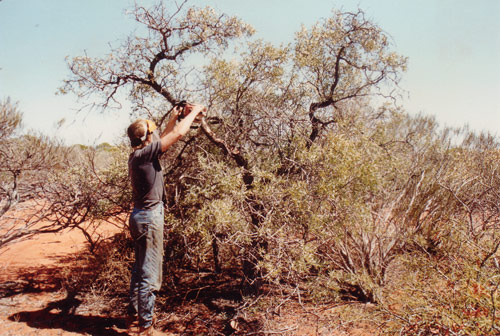Sandalwood
Sandalwood (Santalum spicatum) is best known for aromatic oil and timber used in the production of incense, perfumes and cosmetics. Sandalwood harvesting was one of the first industries in Shark Bay and continued for more than 100 years, mainly for export to south-east Asia. Licences were phased out in the year 2000. Like other members of its family, sandalwood is semi-parasitic and draws most of its nourishment from the roots of surrounding plants.
In most areas sandalwood is harvested by being pulled from the ground, roots and all, but Shark Bay sandalwood is unusual in its ability to coppice, resprout from the stump after being cut down. The new shoots start producing seed after three to four years, ensuring a sustainable harvest. Harvesters working on Nanga pastoral lease in the early 1990s reworked trees that had been cut down during the 1930s.
It is not clear why the Shark Bay sandalwood can resprout but possibilities include the deeper red sand loams encourage a bigger tap root system that can support coppice growth; dead finish (Acacia tetragonophylla) may be a better host plant than those favoured by sandalwood in other areas; or the herbivore defence qualities of the Shark Bay sandalwood’s unusually bitter leaves.
Sandalwood fruit is edible. The golden-brown fruits are 15–20 mm in diameter, have a thin fleshy layer which can be dried and stored, and are delicious when seasoned and roasted. The nuts also produce high quality oil, which some Aboriginal people use as liniment on aching joints. Sandalwood fruits are swallowed whole and dispersed by emus.

